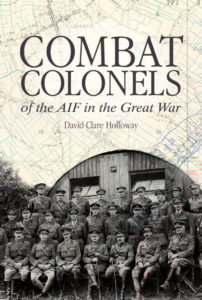by David Clare Holloway
Combat Colonels is not a book to read – it is a biographical reference book listing all the commanding officers who led battalions during World War I.
Every AIF soldier of the Great War regarded his battalion as his adopted family. This was where he felt he belonged. At the head of that unit was the commanding officer or CO – the lieutenant colonel who commanded the men, trained them, led them into action and who rallied those remaining after battle.
David Holloway, the son of an AIF veteran of the 41st Battalion who served from Passchendaele to the Hindenburg Line, asked his father the name of the man who had commanded his battalion. He replied testily: “Goodness knows, we were much too busy to worry about that!” Similarly, the official histories and many of the unit histories often refer to the unit’s CO as ‘the CO’ or ‘the old man’.
Holloway discovered that the 41st Battalion had not one CO, but three. And so it was reflected with most AIF combat units. Age, exhaustion, wounds, death and promotion all contributed to the rotation of battalion and formation COs. By the end of the war, CO appointees for the 60 infantry battalions; 15 light horse regiments; 25 artillery brigades; 5 machine-gun, 5 pioneer, 2 cyclist, and 4 camel corps battalions; and 5 ammunition columns; reached almost 500 – the number of individual appointments numbering close to 2,000.
Combat Colonels seeks to address a regrettable gap in Australia’s documented history of its ‘combat colonels’. Its purpose is to name all the COs who led units into action in the Great War and to describe their lives before and, for those who survived, after the war. From these pages emerge the men who shaped Australia’s battlefield history – both the professional soldiers and the former teachers, accountants, salesmen, clerks, farmers and others from a broad range of occupations whose leadership on and off the battlefield proved so crucial.
Holloway served briefly in the Royal Australian Navy towards the end of WWII. A teacher after the war he taught and was head teacher at various Victoria country schools before becoming a School Inspector. He also author of Dark Somme Flowing (Australian WWI Poetry) and The Inspectors (a history of school inspectors in Victoria.)
Combat Colonels includes a comprehensive list of abbreviations and a glossary. It is organised into six parts: infantry units, pioneer units, light horse units, camel corps units, artillery units and flying corps units. The book includes a generous number of black and white photographs but no maps. There are 16 appendices, a roll of honour, a comprehensive list of sources and further reading, as well as a detailed index.
In all, Combat Colonels is a comprehensive reference work of tremendous value to historians and genealogists.

Contact Marcus Fielding about this article.






